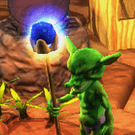The off-mesh connection usage in the crowd navigation example is quite primitive. The agent goes to one end of the connection and instantly appears on the other end.
I subscribed the
E_CROWD_AGENT_STATE_CHANGED
and found it never sends any event related to off-mesh link. Then I found
CA_STATE_OFFMESH
is just a place-holder in
CrowdAgentState
and never used anywhere in the code. So I suppose it’s not supported yet in Urho3D?
Anyone has done something similar in real project how to get information about agent reaching start/end side of the connection and trigger related animation, etc?
My ultimate goal is that the character can:
- climb up/down a vertical ladder;
- jump up/down within given height diff;
- jump horizontally between a gap.
It should be very similar to this video .
There it looks easier since we can disable the Auto Traverse Offmesh Links in Unity, and it should be firing enough events to detailed agent state information too.
How should I do it in the framework of Urho3D? Does the Raycast&Detour lib itself support these and just need to implement them into Urho3d?
Another question
is about the shape of OffMeshConnection triggering area. From current implementation, it looks like the end of each connection is only a circle given a radius. What I would like to have, is to have a narrow rectangle as the triggering area. For example, the whole edge of the wall, can be the start of the connection, and the ground under the wall can be the end of the connection. So the agent can “jump” off the wall
at ANY place
near the wall edge, instead of manually set different points everywhere.
Is this even possible with the Raycast&Detour lib too?




 (although not impossible, it does take a long time, believe me I’ve tried (and still haven’t finished):
(although not impossible, it does take a long time, believe me I’ve tried (and still haven’t finished):

